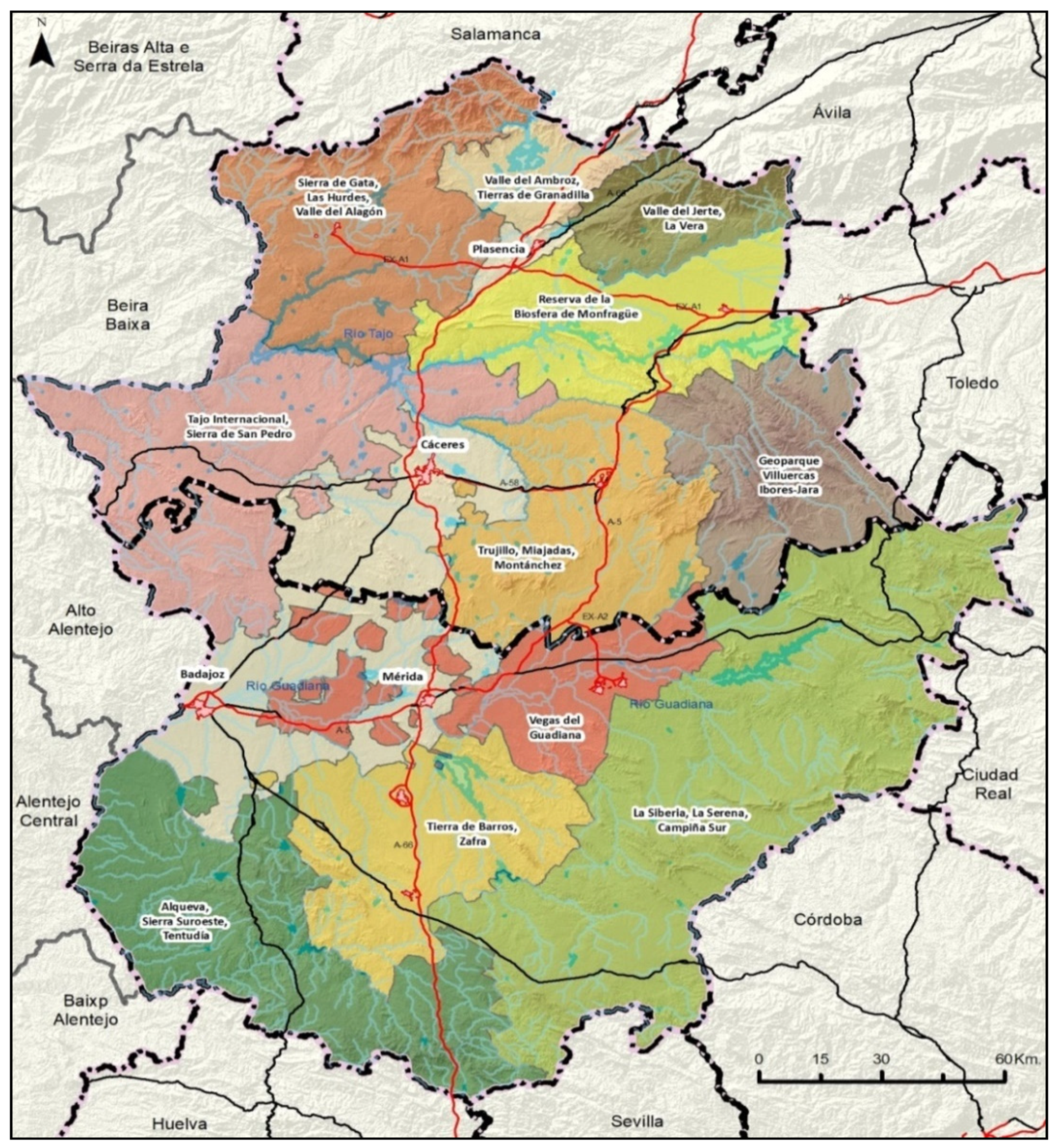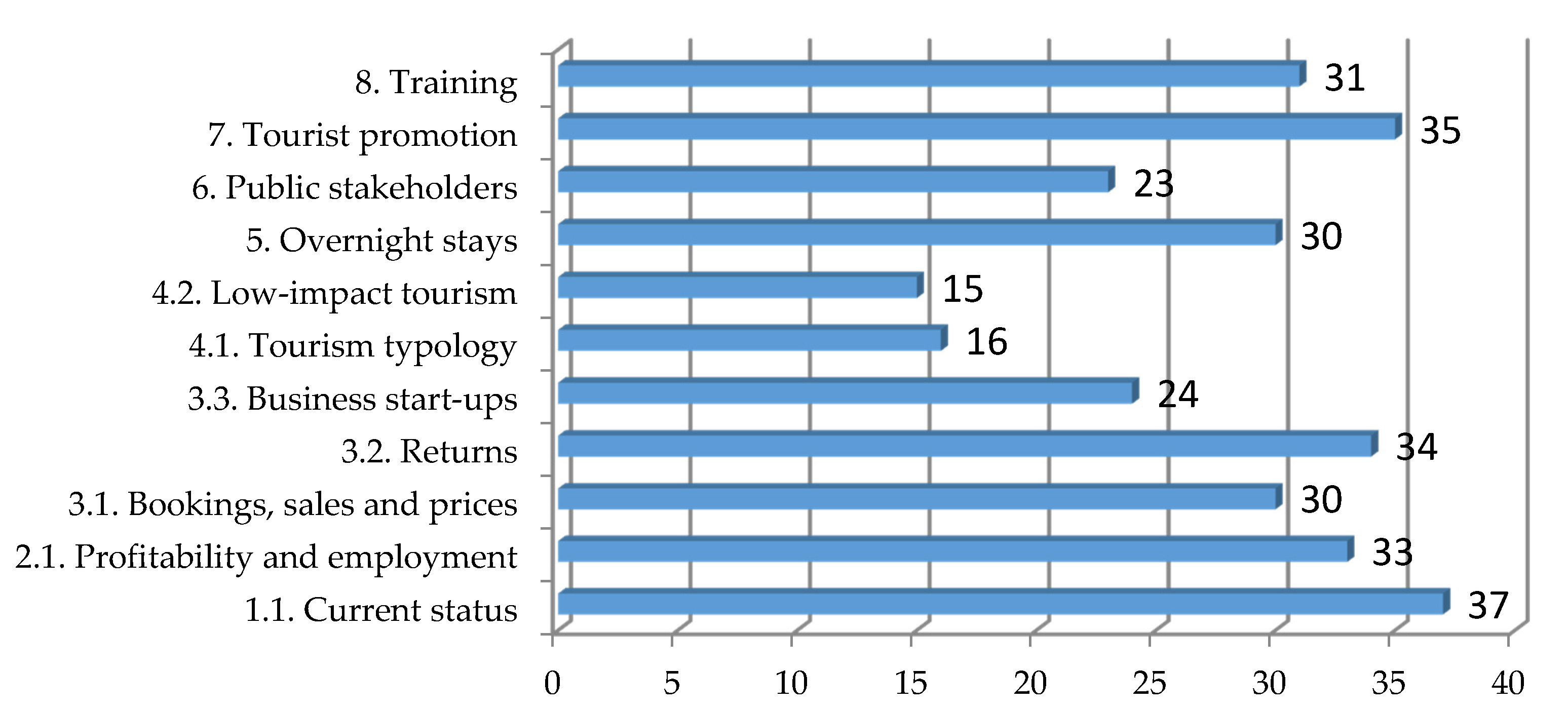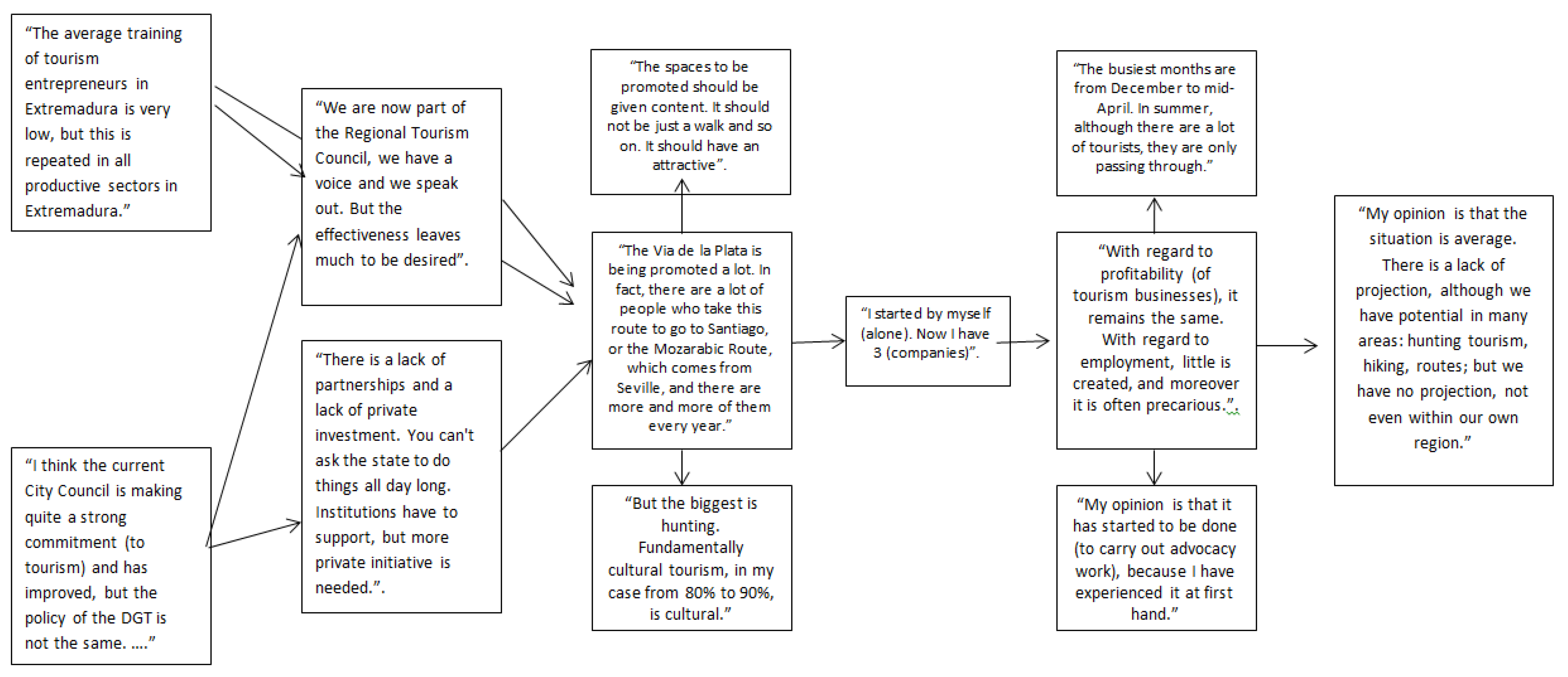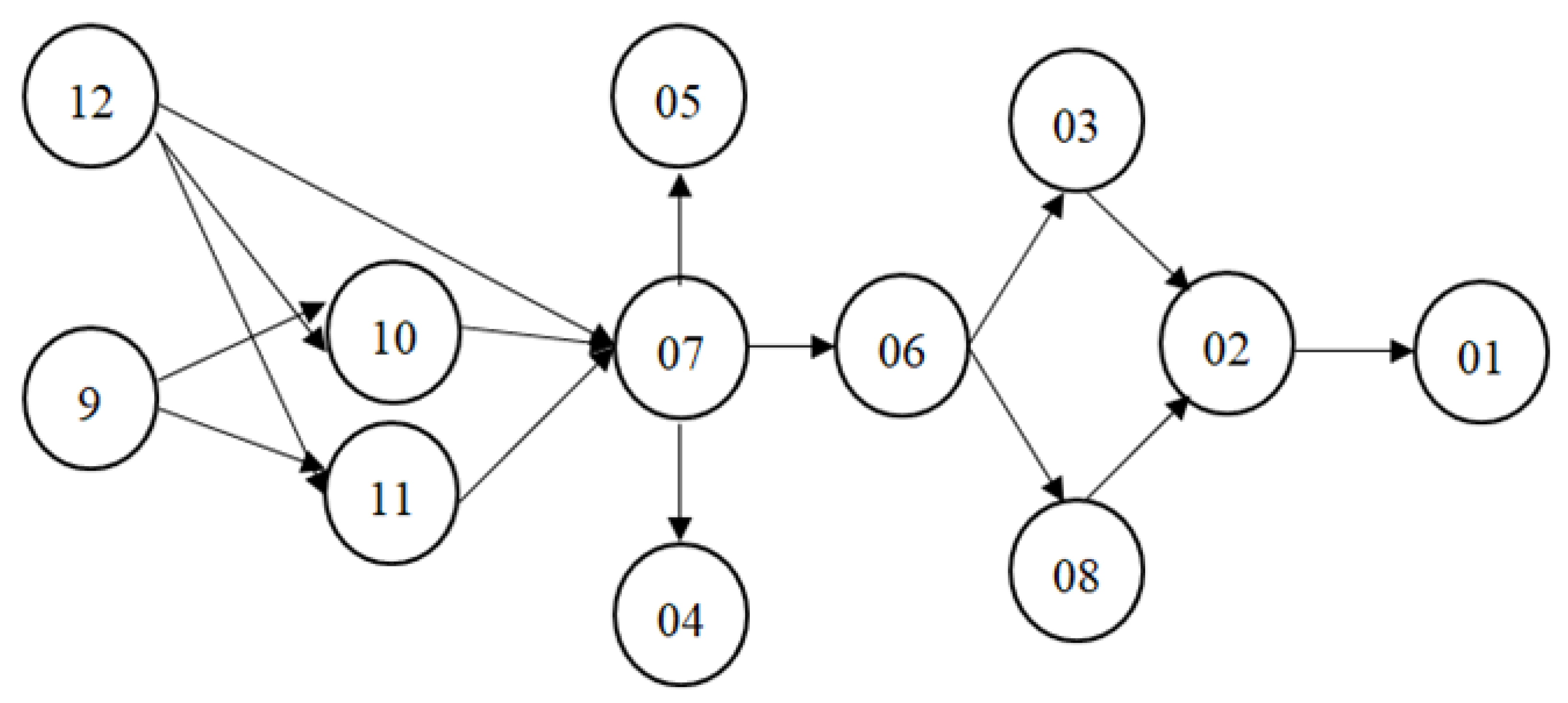Stakeholders’ Participation in Sustainable Tourism Planning for a Rural Region: Extremadura Case Study (Spain)
Abstract
1. Introduction
2. Literature Review
3. Materials and Methods
3.1. Methodology and Study Area
3.2. Research Proposals
4. Research Implementation
5. Results
General Discourse Analysis
- Firstly, to move from being agents who inform public policies to agents who “contribute” to these policies; that is, to take a step further in their involvement as part of the human team that designs public policies (10, Proposition 6, in accordance with Buhalis and Michopoulou [55]) and the promotion of tourism in the region (11, Proposition 7, according to González-Herrera and Álvarez-Hernández [52] and to Buhalis and Michopoulou [55]).
- Promote a shift that reinforces the coordination of tourism policies (in which, in addition to the Regional Government, provincial governments and municipalities are competent) (09, Proposition 6). This “shift” also implies involving the private sector in the design of public policies (10, Proposition 6), and in tourism promotion (11, Proposition 7).
- Both the training of tourism professionals (12, Proposition 8) and the active role of the private sector (10; 11, Proposition 6 and 7), and the correct design of public policies by the regional administration, in the opinion of the focus group members, should contribute decisively to obtaining the necessary return on investment (07, Proposition 2 and 3, in line with Wilson, Fesenmaier, Fesenm, and Van Es [51], with Lindroth, Ritalahti, and Soisalon [21], and with Aichholzer [58]) in tourism activities in Extremadura.
6. Discussion
7. Conclusions
Author Contributions
Funding
Data Availability Statement
Acknowledgments
Conflicts of Interest
References
- Ortí, A. La apertura y el enfoque cualitativo o estructural: La entrevista abierta semidirectiva y la discusión de grupo. In El Análisis de la Realidad Social. Métodos y Técnicas de Investigación; Alianza Editorial: Madrid, Spain, 1986; Volume 176. [Google Scholar]
- Fiske, M.; Kendall, P.L.; Merton, R. The Focused Interview. A Manual of Problems and Procedures; Free Press: Glencoe, IL, USA, 1956. [Google Scholar]
- Giner, S.; Emilio-Torres, C. Diccionario de Sociología Alianza; Editorial SA: Madrid, Spain, 1998. [Google Scholar]
- Gibbs, A. Focus groups. Soc. Res. Update 1997, 19, 1–8. [Google Scholar]
- Grudens-Schuck, N.; Allen, B.L.; Larson, K. Focus Group Fundamentals: Methodology Brief; Iowa State University Extension PM: Ames, IA, USA, 2004. [Google Scholar]
- Weeden, C. A qualitative approach to the ethical consumer: The use of focus groups for cognitive consumer research in tourism. In Tourism Research Methods: Integrating Theory with Practice; CABI: Wallingford, UK, 2005; pp. 179–190. [Google Scholar]
- Gutiérrez Brito, J. La Investigación Social del Turismo; Thomson: Madrid, Spain, 2007. [Google Scholar]
- Taylor, S.J.; Bogdan, R. Introducción a los Métodos Cualitativos de Investigación; Ediciones Paidós: Barcelona, Spain, 1987; Volume 1. [Google Scholar]
- Riley, R.W.; Love, L.L. The state of qualitative tourism research. Ann. Tour. Res. 2000, 27, 164–187. [Google Scholar] [CrossRef]
- Northcote, J.; Macbeth, J. Conceptualizing yield: Sustainable tourism management. Ann. Tourism Res. 2006, 33, 199–220. [Google Scholar] [CrossRef]
- Jacobsen, J.K.S. Anti-tourist attitudes: Mediterranean charter tourism. Ann. Tour. Res. 2000, 27, 284–300. [Google Scholar] [CrossRef]
- Ibañez, J. Cómo se realiza una investigación mediante grupos de discusión, en. In El Análisis de la Realidad Social. Métodos y Técnicas de Investigación; Alianza Editorial: Madrid, Spain, 2010; pp. 57–98. [Google Scholar]
- Qiu, H.Z.; Yuan, J.J.; Ye, B.H.; Hung, K. Wine tourism phenomena in China: An emerging market. Int. J. Contemp. Hosp. Manag. 2013, 25, 1115–1134. [Google Scholar]
- Dwyer, L.; Mellor, R.; Livaic, Z.; Edwards, D.; Kim, C. Attributes of destination competitiveness: A factor analysis. Tour. Anal. 2004, 9, 91–101. [Google Scholar] [CrossRef]
- Strielkowski, W.; Riganti, P.; Jing, W. Tourism, cultural heritage and e-services: Using focus groups to assess consumer preferences. Tourismos 2012, 7, 41–60. [Google Scholar]
- Hardy, A. Using grounded theory to explore stakeholder perceptions of tourism. J. Tour. Cult. Chang. 2005, 3, 108–133. [Google Scholar] [CrossRef]
- Guba, E.G. The paradigm dialog. In Proceedings of the Alternative Paradigms Conference, San Francisco, CA, USA, March 1989. [Google Scholar]
- Neuman, W.L.; Kreuger, L. Social Work Research Methods: Qualitative and Quantitative Approaches; Allyn and Bacon: Boston, MA, USA, 2003. [Google Scholar]
- Guba, E.G.; Lincoln, Y.S. Fourth Generation Evaluation; Sage: Thousand Oaks, CA, USA, 1989. [Google Scholar]
- Bristol, T.; Fern, E.F. Exploring the atmosphere created by focus group interviews: Comparing consumers’ feelings across qualitative techniques. Market Res. Soc. J. 1996, 38, 1–9. [Google Scholar] [CrossRef]
- Lindroth, K.; Ritalahti, J.; Soisalon-Soininen, T. Creative tourism in destination development. Tour. Rev. 2007, 62, 53–58. [Google Scholar] [CrossRef]
- Polkinghorne, D.E. Phenomenological research methods. In Existential-Phenomenological Perspectives in Psychology; Springer: Berlin/Heidelberg, Germany, 1989; pp. 41–60. [Google Scholar]
- Patton, M.Q. Qualitative Research & Evaluation Methods: Integrating Theory and Practice; Sage Publications: Thousand Oaks, CA, USA, 2014. [Google Scholar]
- Hu, C.-P.; Chang, Y.-Y.; John, W. Creswell, Research Design: Qualitative, Quantitative, and Mixed Methods Approaches; Sage Publications: Thousand Oaks, CA, USA, 2017; Volume 4, p. 3. [Google Scholar] [CrossRef]
- Sánchez-Hernández, M.I.; Robina-Ramírez, R.; De Clercq, W. Water Management Reporting in the Agro-Food Sector in South Africa. Water 2017, 9, 830. [Google Scholar] [CrossRef]
- Bernard, H.R.; Wutich, A.; Ryan, G.W. Analyzing Qualitative Data: Systematic Approaches; SAGE Publications: Thousand Oaks, CA, USA, 2016. [Google Scholar]
- Sánchez-Oro Sánchez, M.; Robina Ramírez, R. Los Grupos Focales (“focus group”) Como Herramienta de Investigación Turística; Universidad de Extremadura, Servicio de Publicaciones: Badajoz, Spain, 2020. [Google Scholar]
- Pearce, P.L.; Gretzel, U. Tourism in technology dead zones: Documenting experiential dimensions. Int. J. Tour. Sci. 2012, 12, 1–20. [Google Scholar] [CrossRef]
- Rossiter, J. Measurement for the Social Sciences—The C-OAR-SE Method and Why It Must Replace Psychometrics; Springer: New York, NY, USA, 2011. [Google Scholar]
- Gomm, R. Social Research Methodology: A Critical Introduction; Palgrave Macmillan: London, UK, 2008. [Google Scholar]
- Cleland, J. The Wisdom of Whores. E Pisani; Oxford University Press: Oxford, UK, 2008. [Google Scholar]
- Flick, U. An Introduction to Qualitative Research; SAGE Publications: Thousand Oaks, CA, USA, 2006. [Google Scholar]
- Jennings, G. Tourism Research, 2nd ed.; Wiley Milton Qld: Milton, QLD, Australia, 2010. [Google Scholar]
- Krueger, R.a.M.C. Focus Groups—A Practical Guide for Applied Research; Sage Publications Inc.: London, UK, 2000. [Google Scholar]
- Angen, M.J. Evaluating Interpretive Inquiry: Reviewing the Validity Debate and Opening the Dialogue. Qual. Health Res. 2000, 10, 378–395. [Google Scholar] [CrossRef] [PubMed]
- Decrop, A. Triangulation in qualitative tourism research. Tour. Manag. 1999, 20, 157–161. [Google Scholar] [CrossRef]
- Denzin, N.K.; Lincoln, Y.S. The SAGE Handbook of Qualitative Research; SAGE Publications: Thousand Oaks, CA, USA, 2011. [Google Scholar]
- Tribe, J. New Tourism Research; Taylor & Francis: Milton Park, UK, 2005. [Google Scholar]
- Botterill, D. An Autoethnographic Narrative on Tourism Research Epistemologies. Soc. Leis. 2003, 26, 97–110. [Google Scholar] [CrossRef]
- Hardy, A.; Beeton, R.J. Sustainable tourism or maintainable tourism: Managing resources for more than average outcomes. J. Sustain. Tour. 2001, 9, 168–192. [Google Scholar] [CrossRef]
- Gunn, C.A. Emergence of effective tourism planning and development. In Tourism: The State of the Art; Wiley: Hoboken, NJ, USA, 1994; pp. 10–19. [Google Scholar]
- Cole, S. Information and Empowerment: The Keys to Achieving Sustainable Tourism. J. Sustain. Tour. 2006, 14, 629–644. [Google Scholar] [CrossRef]
- Carter, S. Tourists’ and travellers’ social construction of Africa and Asia as risky locations. Tour. Manag. 1998, 19, 349–358. [Google Scholar] [CrossRef]
- Glaser, B.G.; Strauss, A.L. Discovery of Grounded Theory: Strategies for Qualitative Research; Taylor & Francis: Milton Park, UK, 2017. [Google Scholar]
- Morgan, D.L. Qualitative Research Methods: Focus Groups as Qualitative Research; SAGE Publications: Thousand Oaks, CA, USA, 1997; Volume 10, p. 9781412984287. [Google Scholar]
- Krueger, R.A. Focus Groups: A Practical Guide for Applied Research; Sage Publications: Thousand Oaks, CA, USA, 2014. [Google Scholar]
- Byrd Erick, T. Stakeholders in sustainable tourism development and their roles: Applying stakeholder theory to sustainable tourism development. Tour. Rev. 2007, 62, 6–13. [Google Scholar] [CrossRef]
- Osorio, F. Estudio Anual de la Evolución de los Principales Indicadores Turísticos de Extremadura en 2018; Dirección General de Turismo, Junta de Extremadura: Mérida, Mexico, 2019; p. 35. [Google Scholar]
- Sánchez-Oro Sánchez, M.; Nieto Masot, A.; Fernandez Portillo, A.; García García, Y.; Cárdenas Alonso, G. Memoria Turística de Extremadura por Territorios. Perfíl del Turista que Visita Extremadura año 2018; Dirección General de Turismo de la Junta de Extremadura: Mérida, Mexico, 2019. [Google Scholar]
- King, G.; Keohane, R.; Verba, S. Causalidad e inferencia causal. In El Diseño de la Investigación Social: La Inferencia Científica en los Estudios Cualitativos; Alianza: Madrid, Spain, 2000. [Google Scholar]
- Wilson, S.; Fesenmaier, D.R.; Fesenmaier, J.; Van Es, J.C. Factors for success in rural tourism development. J. Travel Res. 2001, 40, 132–138. [Google Scholar] [CrossRef]
- González-Herrera, M.; Alvarez-Hernández, J.A. Diagnóstico participativo del turismo en Ciudad Juárez desde las voces de los actores locales. Rev. Iberoameric. Cienc. 2014, 1, 117–134. [Google Scholar]
- Martinez Quintana, V.; Blanco Gregory, R. Naturaleza y Urbes en el Ocio y el Turismo. Perspectiva Sociológica en la Planificación de los Hábitats de Recreación; Académicas, E., Ed.; Ediciones Académicas: Madrid, Spain, 2011. [Google Scholar]
- Behringer, J.; Buerki, R.; Fuhrer, J. Participatory integrated assessment of adaptation to climate change in Alpine tourism and mountain agriculture. Integr. Assess. 2000, 1, 331–338. [Google Scholar] [CrossRef]
- Buhalis, D.; Michopoulou, E. Information-enabled tourism destination marketing: Addressing the accessibility market. Curr. Issues Tour. 2011, 14, 145–168. [Google Scholar] [CrossRef]
- Hughes, K. Tourist satisfaction: A guided “cultural” tour in North Queensland. Austr. Psychol. 1991, 26, 166–171. [Google Scholar] [CrossRef]
- Santana Leitner, A. Fundamentos Para la Investigación Social; Alianza Editorial: Madrid, Spain, 2013. [Google Scholar]
- Westholm, H.; Aichholzer, G. Prisma Strategic Guideline; Prisma Project; 2003. Available online: Prisma-EU.net (accessed on 10 April 2021).
- Taylor, A.; Prideaux, B. Profiling four wheel drive tourism markets for desert Australia. J. Vac. Mark. 2008, 14, 71–86. [Google Scholar] [CrossRef]
- Hall, C.M.; Valentin, A. Content Analysis. In Tourism Research Methods. Integrating Theory with Practice; CABI Publishing: Wallingford, UK, 2004; pp. 191–210. [Google Scholar]
- Foessa, F. Informe Sociológico Sobre la Situación Social de España; Euramérica: Madrid, Spain, 1994. [Google Scholar]
- Sánchez-Oro Sánchez, M. Aproximación socilogica al turismo en Extremadura. In Recursos Turísticos, Territorio y Sociedad en Extremadura: Catalogación, Nuevos Usos y Perspectivas; Servicio de Publicaciones de la Universidad de Extremadura: Cáceres, Spain, 2021. [Google Scholar]
- Urry, J.; Larsen, J. The Tourist Gaze 3.0; Sage: Thousand Oaks, CA, USA, 2011. [Google Scholar]
- Light, D.; Creţan, R.; Voiculescu, S.; Jucu, I.S. Introduction: Changing Tourism in the Cities of Post-communist Central and Eastern Europe. J. Balkan Near East. Stud. 2020, 22, 465–477. [Google Scholar] [CrossRef]
- Adams, K.; Crang, M.; Edensor, T.; Flusty, S.; Jacobs, J.; Raento, P.; Urry, J.; Veijola, S.; Wang, N. Travels in Paradox: Remapping Tourism; Rowman & Littlefield Publishers: Lanham, MD, USA, 2006. [Google Scholar]
- Sheller, M.; Urry, J. Tourism Mobilities: Places to Play, Places in Play; Routledge: London, UK, 2004. [Google Scholar]




| Stages | |
|---|---|
| (1) Objectives: Research Proposals | |
| (2) Definition based on theory: Main categories—Subcategories | |
| (3) Codebook | 3.1. Formative reliability check |
| (4) Working through reports (code merging) | 4.1. Summative reliability check |
| (5) Interpretation of the results | |
| Discussion/Conclusions |
| Invited | Attending | Entrepreneurs | Technicians | Duration | |
|---|---|---|---|---|---|
| FG_CÁCERES | 14 | 9 | 4 | 5 | 130’ |
| FG_MÉRIDA | 14 | 5 | 1 | 4 | 85’ |
| FG_PLASENCIA | 14 | 7 | 3 | 4 | 115’ |
| FG_BADAJOZ | 14 | 6 | 1 | 5 | 120’ |
| FG_ZAFRA | 14 | 6 | 4 | 2 | 120’ |
| FG_GUADALUPE | 14 | 5 | 2 | 3 | 80’ |
| Total | 84 | 38 | 15 | 23 |
| Categories and Codes of Propositions 1 | Definition | Authors |
|---|---|---|
| Proposition 1. Current situation of tourism in Extremadura | ||
| 1.1. Higher growth | General economic outlook for the sector in relation to economic growth. | Tribe [38], Hardy [16], Wilson, Fesenmaier, Fesenm, and Van Es [51], González-Herrera and Álvarez-Hernández [52] |
| 1.2. Coordination and institutional support | Assessment of institutional relations between companies and the administration, according to each tourist area. | |
| Proposition 2. Profitability and employment | ||
| 2.1. Employment status | Referred to the working conditions of employees, which include, in general, deficient qualifications. | Hardy [16] |
| 2.2. Institutional support | Referred to the sources of financing and subsidies for business initiatives within this tourism sector. | Wilson, Fesenmaier, Fesenm, and Van Es [51] |
| Proposition 3. Evolution of the tourism business | ||
| 3.1. Bookings, sales, and prices | Stakeholders’ perception of profitability in terms of “bookings, sales, and prices”. | Hardy [16], Lindroth, Ritalahti, and Soisalon [21], Aichholzer [58] |
| 3.2. Return on investment | Return on investments made in the sector | |
| 3.3. Companies | Creation of companies and entrepreneurship initiatives in the tourism sector. | |
| Proposition 4. Typology of tourism | ||
| 4.1. Types to be enhanced | In certain tourist areas, there are types of tourism that should be promoted (Agrotourism, Hunting, Astrotourism etc.). | Strielkowski, Riganti, and Wang [15] |
| 4.2. Types to be regulated | There are areas that show high levels of tourist saturation that can cause rejection by the population. | Jacobsen [11] |
| Proposition 5. Overnight stays | ||
| 5.1. Increase in overnight stays | It is understood that an increase in overnight stays is an indicator of a favorable evolution of the tourism business. | Hardy [16], Wilson, Fesenmaier, Fesenm, and Van Es [51], Lindroth, Ritalahti, and Soisalon [21], Martinez Quintana and Blanco Gregory [53] |
| 5.1. Overnight stays down | It is understood that a decrease in overnight stays is an indicator of an unfavorable evolution of the tourism business. | |
| Proposition 6. The role of tourism stakeholders | ||
| 6.1. Integrated and coordinated sector | Generates solid negotiating positions in future regulations and resource allocation. Promotes a good brand and regional reputation. | Strielkowski, Riganti, and Wang [15], González-Herrera and Álvarez-Hernández [52], Behringer, Buerki and Fuhrer [54] |
| 6.2. Disintegrated and competing sector | Weakens negotiating positions in future regulations and resource allocation. General reputational damage to the brand and the region. | Buhalis and Michopoulou [55] |
| Proposition 7. Tourism promotion | ||
| 7.1. The role of institutions and the role of companies | The positioning of the region in a complex market requires investments in promotion. | González-Herrera and Álvarez-Hernández [52] |
| 7.2. The problem of communications (train and airplane) | Investment in promotion may be conditioned by infrastructure problems that make the destination attractive but inaccessible. | Buhalis and Michopoulou [55], Martinez Quintana and Blanco Gregory [53] |
| Proposition 8. Specific training | ||
| 8.1. Improving qualification | Specific training that has an impact on the quality of services rendered. | Behringer, Buerki and Fuhrer [54], Hughes [56] |
| 8.2. Entrepreneurship | Training for tourism entrepreneurship. | Wilson, Fesenmaier, Fesenm and Van Es [51] |
| BADAJOZ | CÁCERES | MÉRIDA | ZAFRA | PLASENCIA | GUADALUPE | Total | |
|---|---|---|---|---|---|---|---|
| Discursive axes | |||||||
| 1.1. Current status | 7 | 7 | 7 | 6 | 5 | 5 | 37 |
| 2.1. Profitability and employment | 6 | 7 | 5 | 6 | 5 | 4 | 33 |
| 3.1. Bookings, sales, and prices | 7 | 6 | 5 | 5 | 4 | 3 | 30 |
| 3.2. Returns | 7 | 6 | 7 | 5 | 4 | 5 | 34 |
| 3.3. Business start-ups | 3 | 6 | 4 | 4 | 3 | 4 | 24 |
| 4.1. Tourism typology | 3 | 3 | 3 | 2 | 3 | 2 | 16 |
| 4.2. Low-impact tourism | 3 | 3 | 3 | 2 | 2 | 2 | 15 |
| 5. Overnight stays | 6 | 6 | 7 | 4 | 4 | 3 | 30 |
| 6. Public stakeholders | 4 | 6 | 5 | 3 | 3 | 2 | 23 |
| 7. Tourist promotion | 7 | 6 | 7 | 6 | 5 | 4 | 35 |
| 8. Training | 6 | 6 | 6 | 4 | 5 | 4 | 31 |
| Total references per FG | 59 | 62 | 59 | 47 | 43 | 38 | 308 |
| Participants/time | |||||||
| Number of participants in each FG | 6 | 9 | 5 | 6 | 7 | 5 | 38 |
| Time in minutes of each FG | 120’ | 130’ | 85’ | 120’ | 115’ | 80’ | 650’ |
| Correlation | |
|---|---|
| GLOBAL PERFORMANCE INDICATORS | |
| Time/total references (mentions) | 0.95 |
| Number of participants/time | 0.79 |
| Number of participants/mentions | 0.49 |
| PERFORMANCE INDICATORS BY FG, According to the number of mentions they produce, in relation to the total. | |
| ZAFRA | 0.94 |
| BADAJOZ | 0.92 |
| PLASENCIA | 0.91 |
| MÉRIDA | 0.89 |
| CÁCERES | 0.87 |
| GUADALUPE | 0.84 |
| Figure 4 Code | Meaning |
|---|---|
| 01 | Improvement of the situation of tourism in Extremadura |
| 02 | Improvement in profitability and employment in the region |
| 03 | Increase in reservations and sales |
| 04 | Types of tourism |
| 05 | Tourism that is considered to have a low impact or which has the potential for a greater impulse |
| 06 | Return on investment to the private sector |
| 07 | Return on investment in tourism activities |
| 08 | Increase in the average rate of overnight stays |
| 09 | Coordination of tourism policies (in which, in addition to the Regional Government, provincial governments and municipalities are competent) |
| 10 | Public policies’ design |
| 11 | Promotion of tourism in the region |
| 12 | Training of tourism professionals |
Publisher’s Note: MDPI stays neutral with regard to jurisdictional claims in published maps and institutional affiliations. |
© 2021 by the authors. Licensee MDPI, Basel, Switzerland. This article is an open access article distributed under the terms and conditions of the Creative Commons Attribution (CC BY) license (https://creativecommons.org/licenses/by/4.0/).
Share and Cite
Sánchez-Oro Sánchez, M.; Castro-Serrano, J.; Robina-Ramírez, R. Stakeholders’ Participation in Sustainable Tourism Planning for a Rural Region: Extremadura Case Study (Spain). Land 2021, 10, 553. https://doi.org/10.3390/land10060553
Sánchez-Oro Sánchez M, Castro-Serrano J, Robina-Ramírez R. Stakeholders’ Participation in Sustainable Tourism Planning for a Rural Region: Extremadura Case Study (Spain). Land. 2021; 10(6):553. https://doi.org/10.3390/land10060553
Chicago/Turabian StyleSánchez-Oro Sánchez, Marcelo, José Castro-Serrano, and Rafael Robina-Ramírez. 2021. "Stakeholders’ Participation in Sustainable Tourism Planning for a Rural Region: Extremadura Case Study (Spain)" Land 10, no. 6: 553. https://doi.org/10.3390/land10060553
APA StyleSánchez-Oro Sánchez, M., Castro-Serrano, J., & Robina-Ramírez, R. (2021). Stakeholders’ Participation in Sustainable Tourism Planning for a Rural Region: Extremadura Case Study (Spain). Land, 10(6), 553. https://doi.org/10.3390/land10060553







